Hamstring
We know hitting your hamstring muscle group can be tough, so we designed these exercises specifically to help your hamstrings grow fast!
No products in the cart
You May Also Like:




BLACK FRIDAY SALE! UP TO 70% OFF!
Free Shipping on Orders $75+
90 Day Money Back Guarantee
1 Year Equipment Warranty
BLACK FRIDAY SALE! UP TO 70% OFF!
Free Shipping on Orders $75+
90 Day Money Back Guarantee
1 Year Equipment Warranty
BLACK FRIDAY SALE! UP TO 70% OFF!
Free Shipping on Orders $75+
90 Day Money Back Guarantee
1 Year Equipment Warranty
BLACK FRIDAY SALE! UP TO 70% OFF!
Free Shipping on Orders $75+
90 Day Money Back Guarantee
1 Year Equipment Warranty
BLACK FRIDAY SALE! UP TO 70% OFF!
Free Shipping on Orders $75+
90 Day Money Back Guarantee
1 Year Equipment Warranty
BLACK FRIDAY SALE! UP TO 70% OFF!
Free Shipping on Orders $75+
90 Day Money Back Guarantee
1 Year Equipment Warranty
BLACK FRIDAY SALE! UP TO 70% OFF!
Free Shipping on Orders $75+
90 Day Money Back Guarantee
1 Year Equipment Warranty
BLACK FRIDAY SALE! UP TO 70% OFF!
Free Shipping on Orders $75+
90 Day Money Back Guarantee
1 Year Equipment Warranty
BLACK FRIDAY SALE! UP TO 70% OFF!
Free Shipping on Orders $75+
90 Day Money Back Guarantee
1 Year Equipment Warranty
We know hitting your hamstring muscle group can be tough, so we designed these exercises specifically to help your hamstrings grow fast!
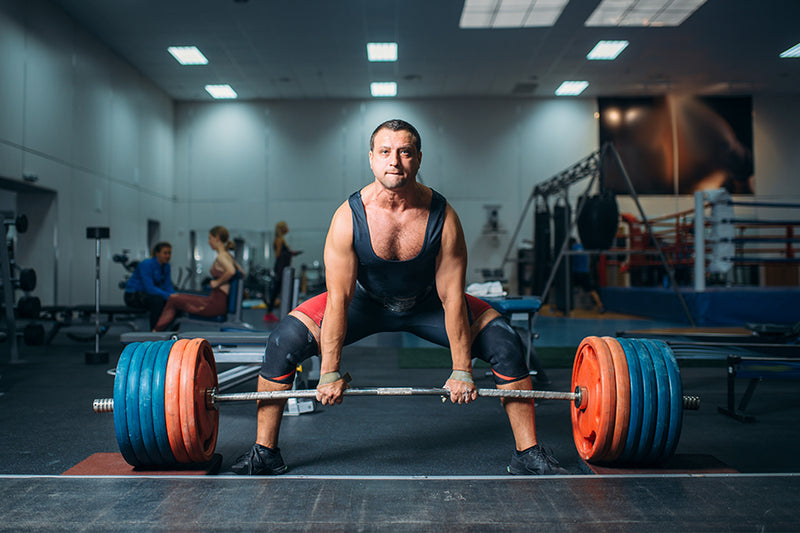
Exercise Description Main Target Muscles Hamstrings Secondary Target Muscles Glutes, Lower Back Workout Type Strength Gym Gear Barbell Fitness Level Beginner Compound/Isolated Compound Power Move Pull Target Muscles: Hamstrings Barbell Stiff Leg Deadlift Overview The hamstrings are the primary target of this strengthening workout. The exercise improves muscle mass and engages the muscle fibres of the hamstrings and glutes. It demands a mind-muscle connection because it is a hamstring isolation workout. After completing this practice, the connection would immediately improve. The activity improves your hip strength, endurance, and form, which improves your athletic performance. The engagement maximizes the strength and size of the hamstrings, calves, and glutes since it concentrates on total leg development. This supports your overarching fitness training objectives. How to Do It? Begin the exercise by choosing a correct barbell and lift by your sides. Stand by bending your knees. Your feet must be placed at shoulder distance apart. Now, you are at your starting position. Bend over to lower the barbell over your feet. Ensure that your back isn’t rounded, it must be as straight as possible. Keep your feet stationary. Continue lowering the barbell till your hamstrings allow you to. You would feel a stretch in your hamstrings at this point, but lower them till the point of your comfort. Squeeze the hamstrings and glutes and stand back straight. Repeat for the desired number of reps. Barbell Stiff Leg Deadlift Tips You are going to end up with a rounded back as soon as you look down. It’s just as simple as that. Keep looking forward. Keep your barbell as close to your body as possible, or else you will put unnecessary strain on your back. Keep your lower back, legs, and abdominal as tight as you can. Keep the weight of your body towards the heels and not to your toes. If you shift your weight at your toes, you’ll be risking your back terribly. Keep the rep timing slow in order to ensure your focus and control over the movement.
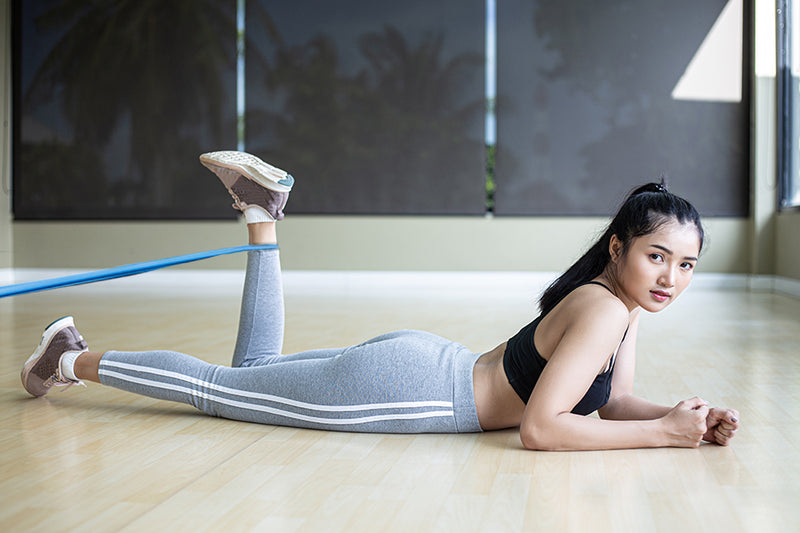
Exercise Description Main Target Muscles Hamstrings Secondary Target Muscles None Workout Type Strength Gym Gear Resistance Band Fitness Level Beginner Compound/Isolated Isolated Power Move Pull Target Muscle: Hamstrings Banded Lying Leg Curl Overview The lying leg curl with resistance band is a great exercise for those looking to work their hamstrings. The hamstrings are the muscles that run along the back of the thigh, and they are responsible for knee flexion. The lying leg curl with resistance band challenges these muscles by providing resistance as you curl your legs up. This exercise can be performed with or without weights, making it a versatile option for all fitness levels. In addition, the lying leg curl with resistance band is a great way to target the inner and outer thighs. By varying your foot placement on the band, you can focus on different areas of the thigh, making this an ideal exercise for sculpting and toning the legs. How to Do It Start by looping one end of the resistance band around a sturdy object and the other end around your ankles. Lay down on your stomach and slowly pull your feet towards your glutes. Be sure to squeeze your hamstrings at the top of the movement. Hold the position for a second, then gradually revert to the initial position. Repeat for the desired number of reps. Banded Lying Leg Curl Tips Make sure your knees stay on the ground throughout the exercise. You should feel a stretch in your hamstrings when you reach the peak of the movement. Keep your movement slow and controlled.
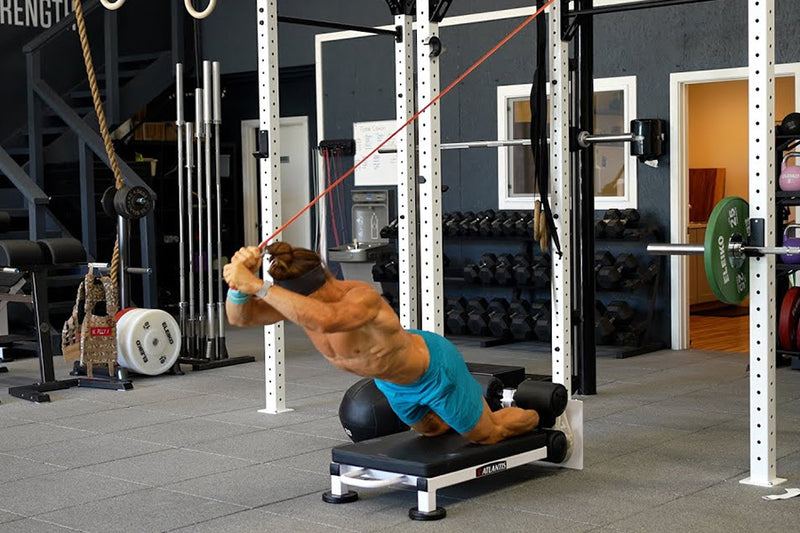
Exercise Description Main Target Muscles Hamstrings Secondary Target Muscles Abs, Calves, Glutes Workout Type Strength Gym Gear Bands Fitness Level Intermediate Compound/Isolated Compound Power Move Pull Target Muscle: Hamstrings Band Nordic Curl Overview The Nordic hamstring curl is a great exercise for people who want to improve their hamstring strength and prevent injuries. You can perform this exercise with or without a resistance band, but using a band provides some additional benefits. First, the band helps keep your knees stable, which reduces the stress on your hamstrings. Second, the resistance provided by the band helps build leg muscles more quickly. Finally, the band provides an extra challenge that can help you stay motivated as you work to improve your strength and flexibility. Whether you're a beginner or a seasoned athlete, the Nordic hamstring curl is a great way to reduce your risk of injury and improve your overall fitness. How to Do Wrap the band around the upper part of the lat pulldown machine. Place your knees on the knee pad and grab the band from behind your head using both your hands. Slowly lower yourself till your body is parallel to the floor. Pull yourself to the starting position by flexing your hamstrings. Repeat for the desired number of reps. Exercise Tips If you prefer a hands-free version, you can wrap the band around your chest as well. Keep your hips extended throughout the movement. If you need more assistance in stretching the band, grab it from a higher point. Be sure you don't feel any contractions in your lower back.
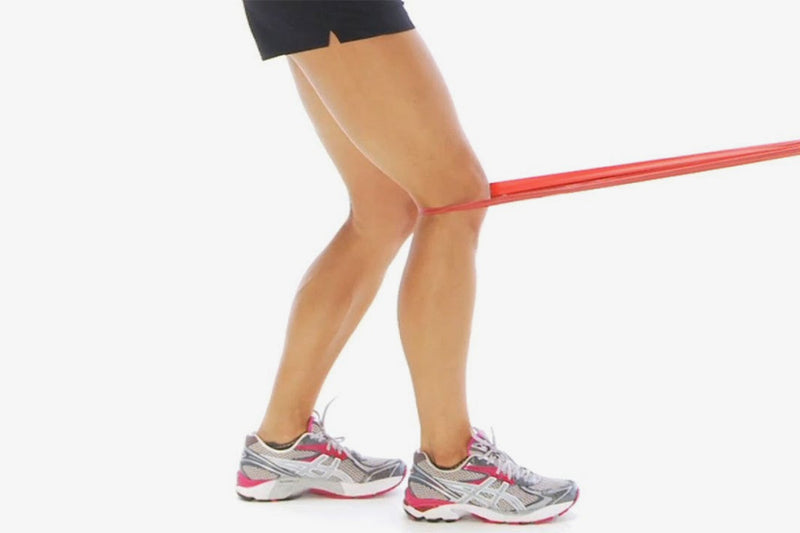
Exercise Description Main Target Muscles Hamstrings Secondary Target Muscles Calves Workout Type Strength Gym Gear Bands Fitness Level Beginner Compound/Isolated Compound Power Move Pull Target Muscle: Hamstrings Terminal Knee Extension Overview Terminal knee extension with a resistance band is one of the most effective exercises for improving knee function. The exercise works by strengthening the quadriceps, which are the muscles that support the knee. In addition, terminal knee extension helps stretch the hamstrings and improve the range of motion in the joint. As a result, exercise can help prevent injuries and improve overall knee health. How to Do Start in a standing position with your feet hip-width apart and the resistance band wrapped around your lower thighs. Hinge forward at your hips and bend your knees to lower into a quarter squat. Drive through your heels to stand back up, extending your legs as you go. As you reach the top of the movement, press the resistance band away from your body to add resistance. Return to the starting position and repeat. Exercise Tips Keep your back straight throughout the exercise. Keep the movements slow and controlled.
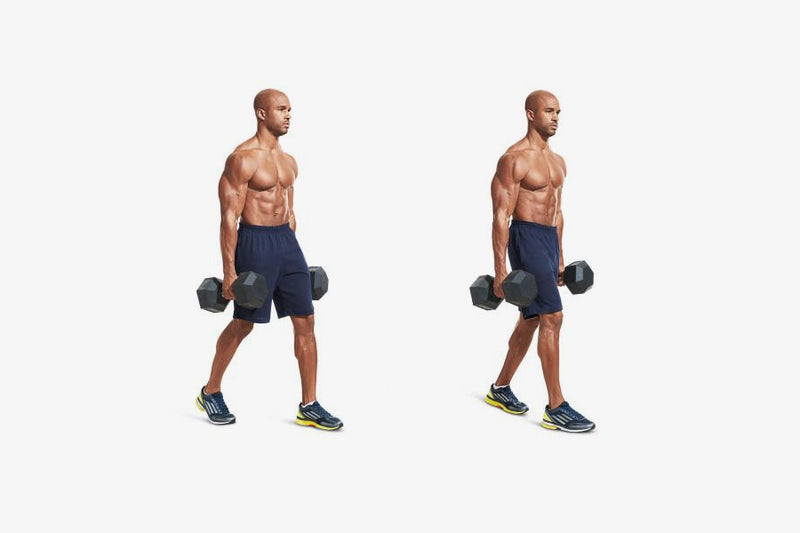
Exercise Description Main Target Muscles Quadriceps, Hamstring, Calves, Glutes Secondary Target Muscles Shoulder, Core Workout Type Strength Gym Gear Dumbbell, Kettlebell Fitness Level Advanced Compound/Isolated Compound Power Move Pull Target Muscles: Quadriceps, Glutes, Calves, Hamstrings, Core, Upper Back, Shoulders, Biceps, and Triceps Farmer’s Walk Overview Farmer’s carry is yet another easy workout. Lift two dumbbells in each hand with weights that are heavy enough for you. Once you’ve gripped the weights correctly, stand up straight, start walking 20 steps in the forwarding direction, and then slowly put the weights back on the ground. How to Do It Stand straight with your feet shoulder-width apart. Arms should be resting at your sides. Place dumbbells on the floor. Squat down a little and grab the dumbbell in each hand. Pull your shoulder blades down and back, engage your core and return to the upright position. Step forward and start walking. Keep your head up and straight, shoulder back and core completely engaged. Walk for 20 steps at least. Farmer’s Walk Tips Make sure to walk in one straight line. Increase the distance and time gradually to get the most out of the exercise. For beginners, it is best to walk for a small distance. Increase your weight gradually to make it more challenging.
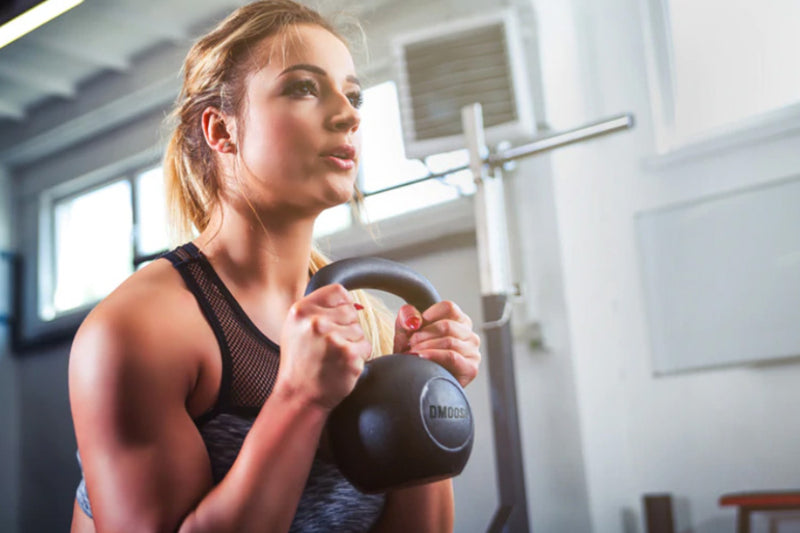
Exercise Description Main Target Muscles Hamstrings Secondary Target Muscles Abs, Adductors, Calves, Forearms, Glutes, Lats, Lower Back, Quads, Traps, Upper Back Workout Type Strength Gym Gear Kettle Bells Fitness Level Intermediate Compound/Isolated Beginner Power Move Hinge Target Muscle: Hamstrings Kettlebell Swings Overview The kettlebell swing is a full-body workout that mainly targets the muscles of the posterior chain with a primary focus on the hamstrings. People who are new to learning the hip hinge position would find this an excellent workout. It will help them massively with several other exercises that involve the hinge, especially deadlifts. It strengthens your weak muscles, builds functional strength, and helps improve your posture. Regardless of the workout program that you are following, kettlebell swings can be healthy incorporation in all. How to Do It Take up a hinged position with your knees slightly bent and hold the kettlebell handle in both your hands. Make sure to keep your chin tucked and weight equally distributed around your foot. Keep your spine neutral and hike the kettlebell between your legs. Then pull the kettlebell back to the starting position by extending your hips and keeping your arms straight. Repeat for the desired number of reps. Kettlebell Swings Tips The swing should generate hip extension as swiftly as possible. Due to the weight, you will experience your toes rising but you shouldn’t allow that. Shift your weight to your heels. Keep your chin tucked in, touching your chest at all times. Ensure you are not keeping a false grip, keep your thumbs around the handle.
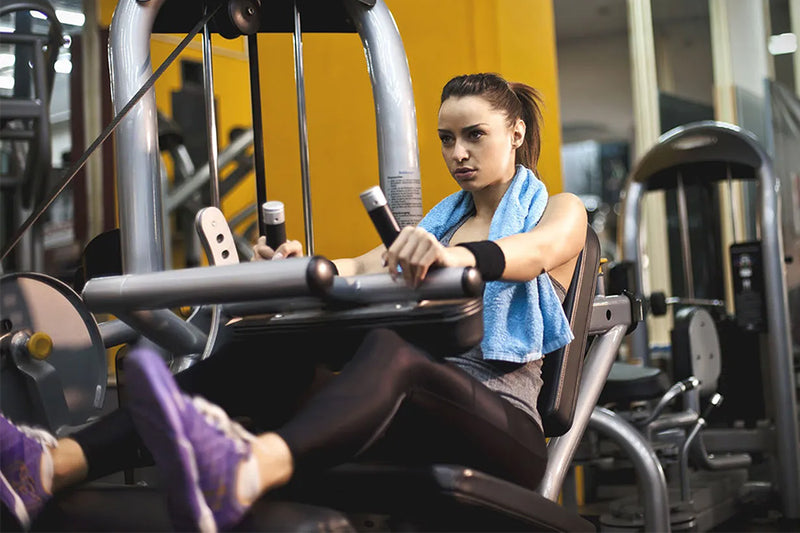
Exercise Description Main Target Muscles Hamstrings Secondary Target Muscles Glutes Workout Type Strength Gym Gear Machine Fitness Level Beginner Compound/Isolated Isolated Power Move Pull Target Muscle: Hamstrings Seated Leg Curl Overview Seated leg curl is an excellent way to work your hamstrings and calves. If your objective is to build muscle mass in your thighs, then this exercise is an ideal way to build more power. It improves strength and flexibility in the legs and prevents your lower back from injuries. Adding in pauses and the timing of the movement completely depends on your individual fitness goals. Whether you are having a leg day or a full-body workout day, this exercise is a must. Other variations include: Lying leg curl Seated leg curl How to Do It Select a weight and rest it comfortably at the back of your heels. Tense your hamstrings and take off the weight from the rack. Make sure to keep your low back flat against the pad. Take your weight up as far as possible until your hamstrings are squeezed. Then return to the starting position. Repeat for the desired number of reps. Seated Leg Curl Tips Make sure to keep the tension in your hamstrings intact throughout the movement. Keep your hips fixed against the seat and do not let your back round up. Your head should not protrude forward. Keep your movement controlled.
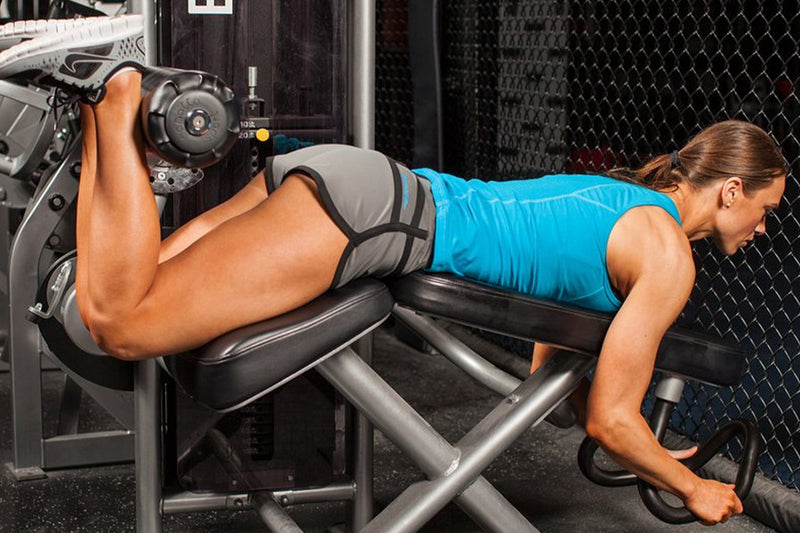
Exercise Description Main Target Muscles Hamstrings Secondary Target Muscles None Workout Type Strength Gym Gear Machine Fitness Level Beginner Compound/Isolated Isolated Power Move Pull Target Muscle: Hamstrings Lying Leg Curl Overview Lying leg curl directly focuses on your hamstrings building power and flexibility in your legs. If performed with the correct form and technique, leg curls hold the ability to enhance the overall strength of your leg. It mitigates the risk of a knee injury, improves mobility, and promotes muscle growth. You can perform this exercise in an isolated manner on the machine or increase the intensity by adding dumbbells to it. How to Do It Lie down on the machine on your belly and place your legs under the cushioned pads. Make sure to lock your ankles under the roller. Now curl your legs towards your hips. Contract your hamstrings and your hips throughout the motion. Slowly lower it back to the starting position. Repeat for the desired number of reps. Lying Leg Curl Tips The roller should be placed above the ankles but below the calves. Make sure your hamstrings are fully contracted to utilize the full range of motion. Keep the rep timing slow and controlled.
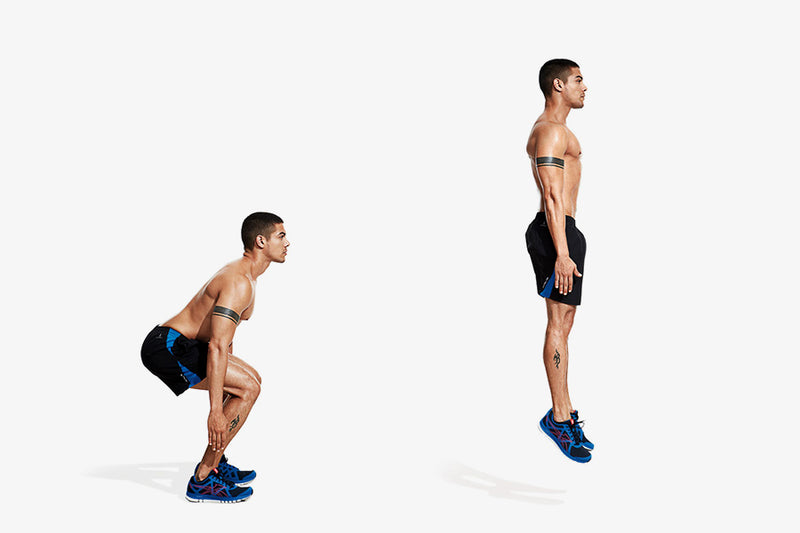
Exercise Description Main Target Muscles Quads Secondary Target Muscles Glutes, Hamstrings Workout Type Plyometrics Gym Gear Bodyweight Fitness Level Beginner Compound/Isolated Compound Power Move Push Target Muscle Group: Quads Jump Squat Overview Jump squats target legs, hips, and thighs. They are the perfect lower muscle builders, easy to do, and absolutely no equipment required. You can do them anywhere: no need to miss out on your muscle-building routine if you follow convenient exercises like this one. If you are an athlete and you want to improve your jumping ability and agility, jump squats will serve as training buddies. They help train your body for high jumps. How to Do It Stand with feet shoulder-width apart and knees bent slightly. Bend your knees some more and lower yourself to a full squat position (like you are sitting in a chair) Engaging the quads, glutes, and hamstrings pull the body up and off the floor, in a jumping manner. With the legs fully extended, the feet will go a few inches (or more) off the floor. Descend and control your landing, and descend further into the squat position again for another rep. When you land, immediately go for another jump Repeat as many times as you can. Tips on Jump Squats Do not go exploding into a squat. Warm up, get your body in the right form and then do the exercise. Do not choose an extra-hard surface for the exercise: choose a flat surface, but not a concrete hard one. Do not overdo it however you may like it. You will not benefit from adding any weights to this exercise: take it easy and do it modestly.
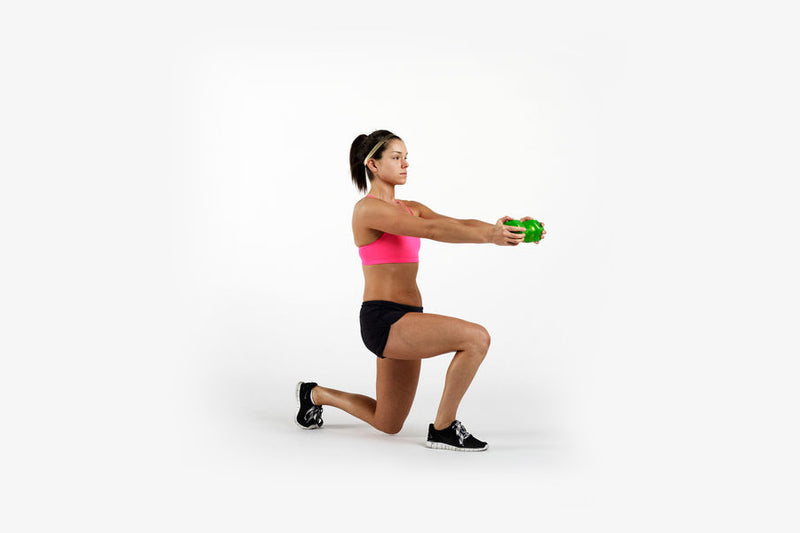
Exercise Description Main Target Muscles Hamstrings, Glutes, and Hip Flexors. Secondary Target Muscles Core, Legs and Obliques Workout Type Strength Gym Gear Dumbbell Fitness Level Beginner Compound/Isolated Compound Power Move Push Target Muscle: Hamstrings, Glutes, and Hip Flexors Alternating Lunge with a Twist Overview Alternating lunge twists can sound to be a scary workout, but it is not that difficult. This is a variation of the basic lunge workout, where instead of getting back up instantly, you twist to your side and then get back up. When performed consistently, this workout can help you strengthen your glutes, hamstrings, and calf muscles effectively. This workout can be easily intensified from a beginner to an intermediate level by adding in heavier dumbbells and increasing the reps of your lunges. You can also try and lunge with smaller steps and wider steps to increase the variation. How to Do It Stand up straight with feet shoulder-width apart Hold a single dumbbell by its sides from both hands, pointed straight ahead. Engaging your core, take a large step forward with your right leg Maintain this lunge position, ensuring the knees of either leg are not touching the floor Twist to your right side and then return your hands in front of you, keeping your hands fully extended. Bring back your right leg to the starting position Now take the left foot ahead and twist to your left side Alternate your legs between the workouts to complete the exercise. Tips for Alternating Lunges with a Twist Always keep your feet straight and not turned either way Keep your hands extended in front of you at all times Keep your back straight and do not lean forward or backward Make sure your knees don’t cross your toes when lunging Keep your heels slightly lifted at all times so you can bounce back from the lunge easily.
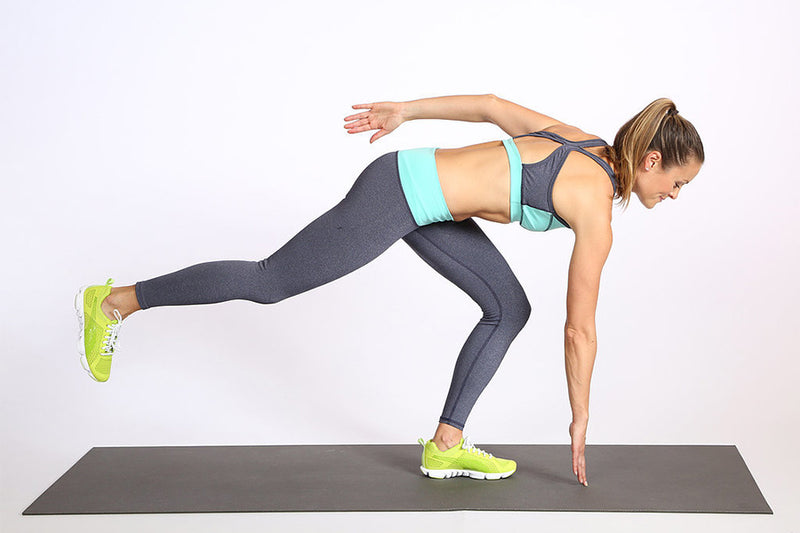
Exercise Description Main Target Muscles Glute Max, Quads, Hamstrings. Secondary Target Muscles Front Shoulders, Lats (back), Lower Back, Neck Flexors Workout Type Strength Gym Gear Dumbbell (Optional) Fitness Level Intermediate Compound/Isolated Compound Power Move Balancing Target Muscle Group: Glute Max, Quads, Hamstrings Single Leg Touchdown Overview Single leg touchdown is a beginner to intermediate level exercise that targets your glutes, quads, and hamstrings. Apart from the core and lower body, a single-leg touchdown is a great workout that helps you improve your body balance, as it requires you to stand on one foot. Even though it is a simple workout, adding heavier dumbbells will allow you to challenge your strength and balance. How to Do It Start by standing with your feet slightly open. Lift your left leg a little and slightly bend the right leg Engaging your core, lean forward, and touch your right leg toes with your fingers Maintain your left leg, spine, and neck in a straight line Slowly return to your position, and repeat the workout Perform all your reps on one leg before moving on the other Tips for Single-Leg Touchdowns Keep your body aligned and well balanced when leaning forward Perform the exercise with controlled movements Intensify the workout by adding in dumbbells and increasing the reps Always make sure to keep your feet tightly grounded to avoid tripping Do not try to do more reps quickly. A slow and focused workout goes a long way than a quick and unfocused workout.
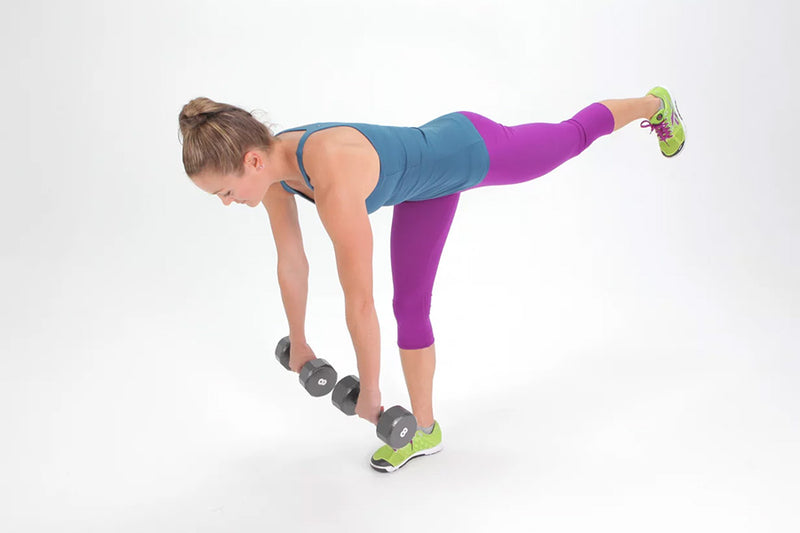
Exercise Description Main Target Muscles Hamstrings Secondary Target Muscles Glutes, Obliques, Abs, Spine, Legs Workout Type Strength Gym Gear Dumbbell Fitness Level Intermediate Compound/Isolated Compound Power Move Pull Target Muscle Group: Glutes and Hamstrings Single Leg Deadlift Overview Single leg deadlift is an intermediate to advanced level workout done using a dumbbell or a barbell, depending on the individual’s fitness level. This workout is a variation of the conventional deadlift. Here the weights are lifted in both hands while the body is balanced upon one leg at a time. This exercise helps you target your glutes and hamstrings simultaneously and help you build a firmer lower body. Furthermore, the individual can target various other muscles such as the core and spinal muscles in this workout and enhance body stability. How to Do It Stand up straight with feet opened hip-width apart and hands placed in front of you. Grab the dumbbells with an overhand grip, i.e., palms facing inwards Balance your body on the left leg and bend your torso forward Once you’re bent forward, the weights should not be touching the ground, while your right leg should be raised and aligned with your back. Slowly lower down your leg to complete one rep Perform all reps on one leg before moving on to the other leg Single Leg Deadlift Tips Perform the workout in a controlled movement and don’t let the hands hang loose Keep your feet grounded on the floor firmly to avoid tripping. Stop immediately if you feel too much pain in your spine. Start with lighter weights and gradually move to heavier weights. Focus on the workout and make a mind-muscle connection to control the movements better and engage your muscles.
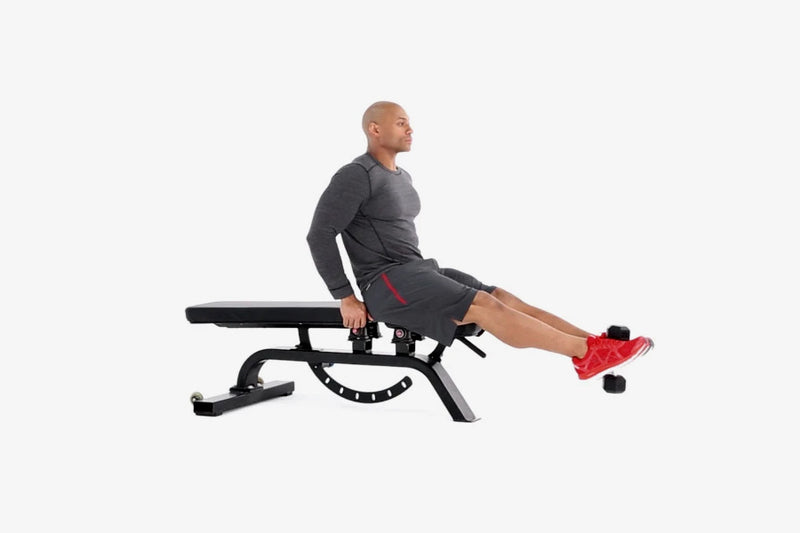
Exercise Description Main Target Muscles Quads Secondary Target Muscles None Workout Type Strength Gym Gear Dumbbell Fitness Level Beginner Compound/Isolated Isolated Power Move Push Target Muscle: Quads Leg Extensions Overview A leg extension is an isolated form of exercise that focuses on the quads primarily. It’s important to note that leg extensions can be pretty hard on the knees so if you already suffer from a knee issue, it would be best to practice other exercises to target quads. It strengthens your quadriceps which are the front of your upper legs. This strength training exercise can be done on a leg extension machine or with a dumbbell at home. How to Do It Choose the required weight of the dumbbell. Adjust the seat, sit down, and position the dumbbell on both your feet equally. Extend your legs and flex your quadriceps. After your legs have locked out, reverse to complete the rep. Lower back to the starting position. Leg Extension Tips The dumbbell should be in line with your knees completely. Make sure you do not put excessive weight on your legs due to the lack of hamstrings contraction which can put your knee at the risk of injury. Keep your toes pointed.
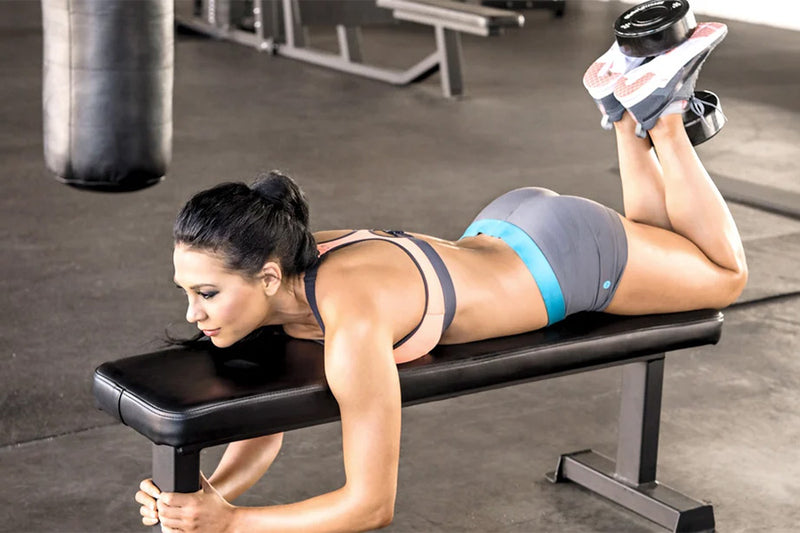
Exercise Description Main Target Muscles Hamstrings Secondary Target Muscles None Workout Type Strength Gym Gear Dumbbell Fitness Level Intermediate Compound/Isolated Isolated Power Move Pull Target Muscle Group: Hamstrings Dumbbell Hamstring Curl Overview Dumbbell hamstring curl directly focuses on your hamstrings, building power and flexibility in your legs. If performed with the correct form and technique, leg curls hold the ability to enhance the overall strength of your leg. It mitigates the risk of a knee injury, improves mobility, and promotes muscle growth. You can perform this exercise in an isolated manner on the machine or increase the intensity by adding dumbbells to it. How to do it To prepare for dumbbell hamstring curls, elevate a flat bench on a step or block to prepare for dumbbell hamstring curls. A flat, grounded bench can be used. However, elevating the bench allows for more motion and better recruitment of the hamstrings. Next, choose the correct dumbbell and place it on the ground at the lower end. Place your face down on the bench, and place your knees at the edge. Grab the dumbbell and place it on the ground with your feet. Secure it between your arches. For stability, your legs should be extended fully and you should wrap your arms around the bench. This is the starting position. Slowly lift the dumbbell towards your buttocks by bending at the knees. The dumbbell should be raised as high as possible, but not beyond 90 degrees. Take a moment to pause, then slowly lower the dumbbell back to its starting position. Repeat for desired reps. Exercise Tips Begin the exercise with a lightweight. Throughout the exercise, you will need to keep your upper body and legs still. A too heavy dumbbell may cause injury by causing your body to swing or jerk. If you have trouble lifting the dumbbell from the ground, a partner can place it between your feet. Before you begin the movement, make sure the dumbbell is secure between your feet. You should focus on lifting the weight using your hamstrings and using a full-range motion.
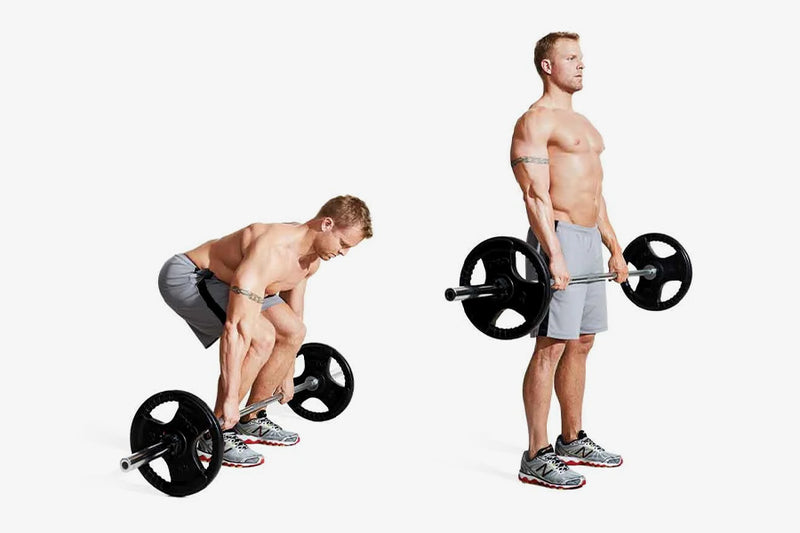
Exercise Description Main Target Muscles Hamstrings Secondary Target Muscles Abs, Forearms, Glutes, Lats, Lower Back, Traps, Upper Back Workout Type Strength Gym Gear Barbell Fitness Level Beginner Compound/Isolated Compound Power Move Hinge Target Muscle: Glutes Romanian Deadlift Overview The Romanian deadlift is just as powerful of an exercise as the name sounds. It is a variation of the conventional deadlift which primarily targets the glutes and hamstrings. The exercise ensures to increase the movement of all the muscles involved in this movement. It enhances movement patterns, minimizes the risk of injury, and improves strength and coordination. This is a highly beneficial exercise regardless of the training purpose. In order to increase your training frequency, try performing the Romanian deadlift on the leg day and another variation of deadlift on your pull days. Since the hip hinge is a critical movement, find a variation that aligns with your comfort level. How to Do It Stand at a hip-width distance and hold the bar over your shoelaces. Place a double overhand grip, slightly wider than your hip-width, and deadlift the bar to the position such that your hips and knees are locked out. Begin the Romanian deadlift by pushing the hips back and extending forward so that the bar is rightly below knee length. Make sure to drive through the whole leg through the movement. Return and repeat for the desired number of reps. Romanian Deadlift Tips The range of motion throughout the exercise is completely dependent upon the mobility and ability of the individual to the spine neutral. If you are picking up an excessively heavy weight, try to do it with the help of hook grips as you might encounter a slipping grip issue. Make sure to keep your neck neutral. Experiment with the neck positions to choose the best option. Make sure the bar doesn’t drift away from the body, It should stay as close to your legs as possible. Do not keep a false grip on the bar and hold it as tight as possible. Shift your weight to your heels and not to the ball of your feet. It should ideally remain equally distributed throughout your foot. Keep your elbows locked out. Make sure your elbow doesn’t break the neutral position as it can pose risk to your bicep.
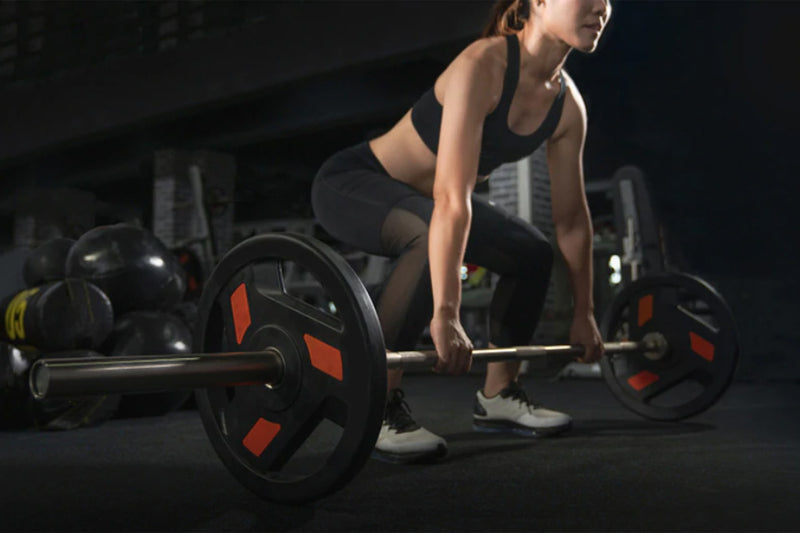
Exercise Description Main Target Muscles Hamstrings Secondary Target Muscles Abs, Adductors, Calves, Forearms, Glutes, Hamstrings, Lats, Lower Back, Middle Back, Quads, Traps, Upper Back Workout Type Strength Gym Gear Barbell Fitness Level Intermediate Compound/Isolated Compound Power Move Hinge Target Muscle: Hamstrings Conventional Deadlift Overview This is a highly popular exercise that is known to build overall body strength. You pick up dead weight off of the ground and lift it up till your hip level. It promotes muscle growth in the entire posterior chain which are the muscles on the back of your body. It is one of the three powerlifting exercises; squats, bench presses, and deadlifts. The exercise primarily works on your hamstrings and indirectly targets abs adductors, calves, glutes, lats, forearms, lower back, middle back, upper back, quads, and traps. The exercise requires you to be adequately skilled in order to pull this off with utmost ease. It should be a staple exercise to be included in every workout program, irrespective of the fitness goals. Some of its popular variations include: Stiff leg deadlift Romanian deadlift Dumbbell deadlift Smith machine deadlift How to Do It Assume a hip-width stance and place the bar above your shoelaces. Hinge forward and push your hips back so that your torso gets parallel to the floor. Pick up the bar with a double overhand grip and pull it slightly. Make sure your armpits are positioned above the bar and are squeezed. As you drop your hips, pull up the bar. Ensure that you’ve pulled the bar up in a straight line as you pick the bar up. Make sure to keep your weight divided in the whole foot equally. Once your hips are locked out, reverse your movement to go back to the starting position. Repeat for the desired number of reps. Deadlift Tips You have to make sure that the crease of your armpit lies over the bar and midfoot. It is important to note that a deadlift is not a squat, it is a hinge. Lowering yourself in a squat position will be severely disadvantageous for you. Squeeze your lats to prevent the bar from drifting away from your body. Experiment with your neck to check if you find it better in a neutral position or while looking straight ahead. Pick one that renders comfort. Angle your toes at your convenience. Experiment with different positions to check which suits you better. Drive through your whole foot when pulling the weight up. Do not flex your triceps and keep your elbows locked out. If you want to perform multiple repetitions of the exercise, pick a weight that is under your control and doesn’t overly fatigue you. Keep your knees positioned over your feet.
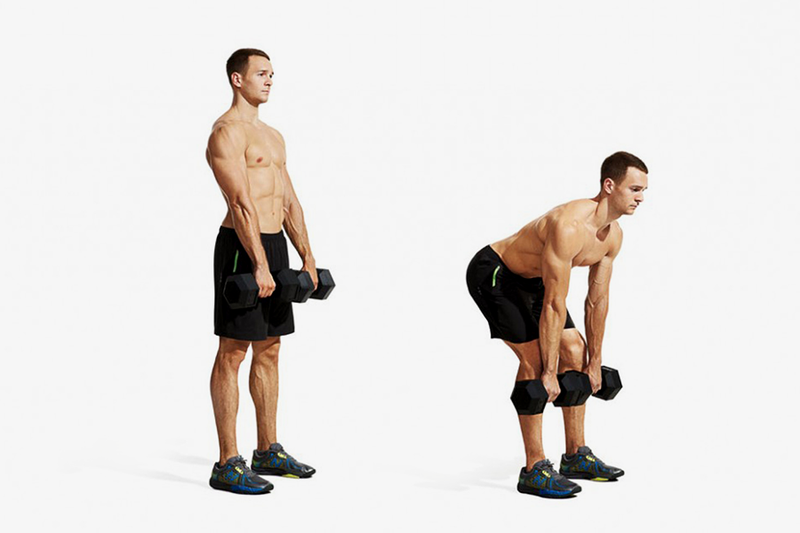
Exercise Description Main Target Muscles Hamstrings Secondary Target Muscles Glutes, Lower Back Workout Type Strength Gym Gear Dumbbell Fitness Level Beginner Compound/Isolated Compound Power Move Pull Target Muscle: Hamstrings Dumbbell Stiff Leg Deadlift Overview This strengthening exercise focuses on the hamstrings individually. The exercise activates the muscle fibers in the glutes and hamstrings and increases the muscle mass. Since it is an isolation exercise for your hamstrings, it requires a mind-muscle connection. You would experience instant enhancement in the connection after performing this exercise. The exercise improves your hip strength, endurance, and form, which enhances your athletic performance. Since it focuses on complete leg development, the engagement maximizes the power and size of hamstrings, calves, and glutes. This complements your overall fitness training aims. How to Do It Begin the exercise by choosing a pair of dumbbells and lift them by your sides. Stand up straight and bend your knees. Your feet should be placed at shoulder width. Now, you are at your starting position. Bend over to lower the dumbbells over your feet. Make sure that your back isn’t rounded, it should be as straight as possible. Keep your feet stationary. Continue lowering the dumbbells till your hamstrings allow you to. You would feel a stretch in your hamstrings at this point, but lower them till the point of your comfort. Squeeze the hamstrings and glutes and stand back straight. Repeat for the desired number of steps. Dumbbell Stiff Leg Deadlift Tips You are going to end up with a rounded back as soon as you look down. It’s just as simple as that. Keep looking forward. Keep your dumbbells as close to your body as possible, or else you will put unnecessary strain on your back. Keep your back, legs, and abdominal as tight as you can throughout the movement. Do not stop or rest at the bottom of the movement. Keep the weight of your body towards the heels and not to your toes. If you shift your weight at your toes, you’ll be risking your back terribly. Keep the rep timing slow in order to ensure your focus and control over the movement. Ensure to push your hips back when you bend over. You need the weight to focus on your hamstrings and not the lower back as it would increase your risk of injury. If you are a beginner, start with a mirror on your side or under the observation of a trainer to keep your technique and form on point.